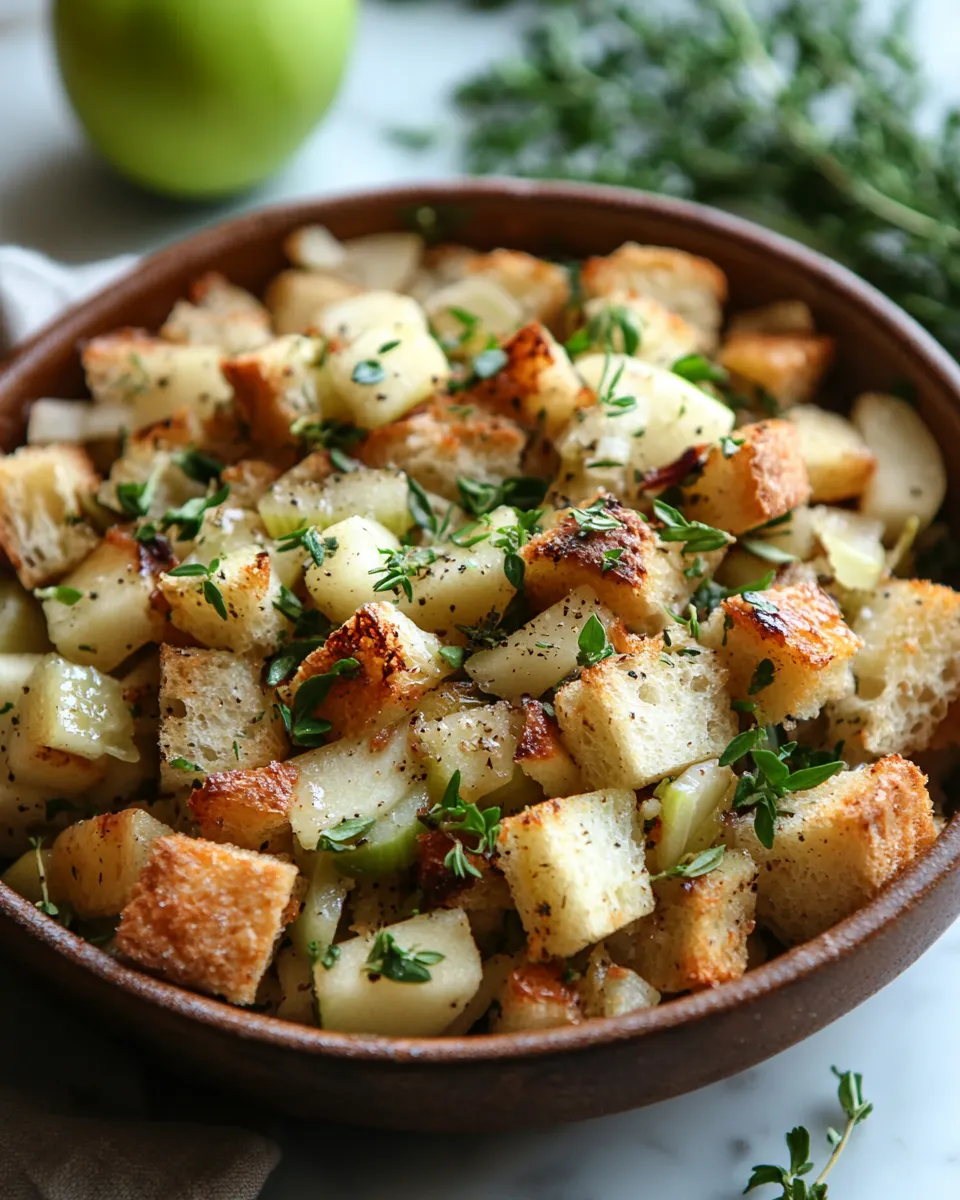There’s something timeless and comforting about a warm dish of homemade stuffing fresh out of the oven. This Caramelized Shallot and Herb Stuffing brings all the cozy, savory flavors you crave during the cooler months. Whether you’re planning a special family gathering or simply want a hearty, flavorful side to complement your favorite roast chicken or turkey, this dish delivers pure comfort in every bite.
The inspiration for this recipe comes from the classic herb stuffing we all know and love, but with a delicious twist — the addition of caramelized shallots. Slowly cooked until golden and sweet, the shallots add depth and richness, perfectly balanced by a medley of fresh herbs and buttery toasted bread. It’s an elegant yet easy dish that captures the warmth of home cooking and the joy of sharing a meal made with care.
Ingredients
-
1 loaf of day-old French or sourdough bread, cut into 1-inch cubes (about 10 cups)
-
6 large shallots, thinly sliced
-
4 tablespoons unsalted butter
-
3 tablespoons olive oil
-
2 celery stalks, finely chopped
-
1 small yellow onion, diced
-
3 cloves garlic, minced
-
2 teaspoons fresh thyme leaves
-
1 tablespoon fresh sage, chopped
-
2 tablespoons fresh parsley, chopped
-
2 cups low-sodium chicken or vegetable broth
-
2 large eggs, lightly beaten
-
Salt and black pepper to taste
-
Optional: ½ teaspoon crushed red pepper flakes for a mild heat
Directions
-
Prepare the Bread:
Preheat your oven to 300°F (150°C). Spread the bread cubes evenly on a large baking sheet and bake for about 15–20 minutes, or until they’re dry and lightly crisp. This helps them soak up the flavorful liquid later. Remove from the oven and let cool completely. -
Caramelize the Shallots:
In a large skillet, heat the butter and olive oil over medium heat. Add the thinly sliced shallots and cook slowly, stirring occasionally, for about 15–20 minutes. The shallots should become soft, golden, and fragrant. Be patient — caramelization brings out their natural sweetness, which makes this stuffing truly shine. -
Sauté Vegetables:
Add the chopped celery and diced onion to the skillet with the caramelized shallots. Cook for another 5–7 minutes until softened and translucent. Add the minced garlic and cook for one more minute, stirring frequently so it doesn’t burn. -
Add Herbs and Seasoning:
Stir in the thyme, sage, and parsley. Season generously with salt and black pepper. If you like a subtle kick, add crushed red pepper flakes at this stage. -
Combine with Bread Cubes:
Transfer the toasted bread cubes to a large mixing bowl. Pour the shallot and herb mixture over the bread and toss gently to combine, ensuring every piece is coated in those buttery, aromatic flavors. -
Add Broth and Eggs:
Gradually pour the chicken or vegetable broth over the mixture, stirring lightly until the bread is evenly moistened but not soggy. Add the beaten eggs and mix again to bind everything together. -
Bake the Stuffing:
Preheat the oven to 350°F (175°C). Lightly grease a 9×13-inch baking dish and spoon the stuffing mixture into it. Cover with foil and bake for 25 minutes. Then, remove the foil and continue baking for another 20 minutes until the top is golden brown and slightly crisp. -
Serve and Enjoy:
Let the stuffing rest for 5–10 minutes before serving. The top should be crunchy, while the inside remains soft and full of flavor — the perfect texture for a comforting side dish.
Prep Time, Cook Time, Total Time, Yield
-
Prep Time: 20 minutes
-
Cook Time: 45 minutes
-
Total Time: 1 hour 5 minutes
-
Yield: 8 servings
Notes
-
Make-Ahead Option: You can prepare the stuffing mixture a day ahead and refrigerate it overnight. Simply bake it the next day before serving.
-
Vegetarian Version: Use vegetable broth instead of chicken broth for a fully vegetarian stuffing.
-
Bread Choice: Sourdough bread adds a tangy flavor, while French bread gives a more neutral base. Use whichever suits your preference.
-
Texture Tip: For a crisper top, bake uncovered for a few extra minutes at the end.
Why You’ll Love This Caramelized Shallot and Herb Stuffing
This stuffing stands out because it strikes the perfect balance between rustic simplicity and refined flavor. The caramelized shallots introduce a hint of sweetness that complements the savory herbs beautifully. Unlike store-bought mixes, this homemade version is fresh, aromatic, and deeply satisfying.
It’s versatile too — pair it with roast chicken, turkey, or even a vegetable casserole. Its rich, buttery aroma will fill your kitchen with that unmistakable warmth that brings everyone together around the table. Whether it’s for a family dinner or a special gathering, this dish transforms an ordinary meal into something memorable.
Tips for Perfect Stuffing Every Time
-
Use Day-Old Bread:
Slightly stale bread absorbs liquid better, giving you that perfect balance between moist and crisp textures. -
Don’t Rush the Shallots:
The secret to their deep flavor is slow cooking. Resist the urge to crank up the heat — caramelization takes time but rewards you with rich, complex sweetness. -
Taste as You Go:
Seasoning is key. Taste your stuffing mixture before baking and adjust with salt, pepper, or herbs to match your preferences. -
Add Texture Variations:
For a little crunch, you can add toasted pecans, walnuts, or even roasted pumpkin seeds just before serving. -
Adjust Moisture Levels:
If your stuffing seems too dry before baking, add a splash more broth. If it’s too wet, mix in a few more bread cubes.
Serving Suggestions
This Caramelized Shallot and Herb Stuffing pairs beautifully with a wide variety of main dishes. It’s especially good alongside:
-
Roast chicken or turkey
-
Baked salmon or white fish
-
Herb-roasted vegetables
-
Creamy mashed potatoes or a vegetable gratin
It’s also delicious served as a vegetarian entrée on its own with a simple green salad on the side. The herb-forward flavors and caramelized shallots make it hearty enough to stand alone while complementing other dishes seamlessly.
Storage and Reheating Tips
-
Refrigerate: Store leftovers in an airtight container in the fridge for up to 4 days.
-
Reheat: Warm in the oven at 350°F for about 15 minutes, or until heated through. You can also microwave individual servings, though the oven helps maintain that crisp top.
-
Freeze: Freeze in a freezer-safe container for up to 2 months. Thaw in the refrigerator overnight before reheating.
Variations to Try
-
Wild Mushroom and Shallot Stuffing:
Add 2 cups of sliced mushrooms to the skillet with the shallots for a rich, earthy flavor. -
Apple and Herb Stuffing:
Mix in 1 diced apple before baking for a touch of sweetness and freshness. -
Savory Vegetable Stuffing:
Add finely chopped carrots, leeks, or spinach for extra color and nutrients. -
Cheesy Shallot Stuffing:
Stir in ½ cup of grated Parmesan or cheddar before baking for a comforting, cheesy twist. -
Whole Grain Bread Stuffing:
Substitute half of the bread with whole grain or multigrain bread for a nuttier, more wholesome flavor.
How to Caramelize Shallots Perfectly
Caramelizing shallots is what gives this dish its signature flavor, and it’s worth doing right. Here’s how to master it:
-
Start with Even Slices:
Slice your shallots uniformly so they cook evenly. -
Use the Right Fat:
A mix of butter and olive oil ensures richness without burning. -
Cook Low and Slow:
Set your heat to medium or medium-low. The goal is gentle cooking for 15–20 minutes, allowing the sugars in the shallots to break down gradually. -
Stir Occasionally:
Stir every few minutes to prevent sticking and to ensure even browning. -
Deglaze if Needed:
If shallots start to stick too much, add a splash of broth or water to lift the fond (the caramelized bits) from the pan — it adds even more flavor.
Nutritional Overview (Per Serving)
-
Calories: ~210
-
Protein: 7g
-
Fat: 9g
-
Carbohydrates: 25g
-
Fiber: 3g
-
Sodium: 340mg
These values are approximate and can vary depending on the bread type and broth used.









